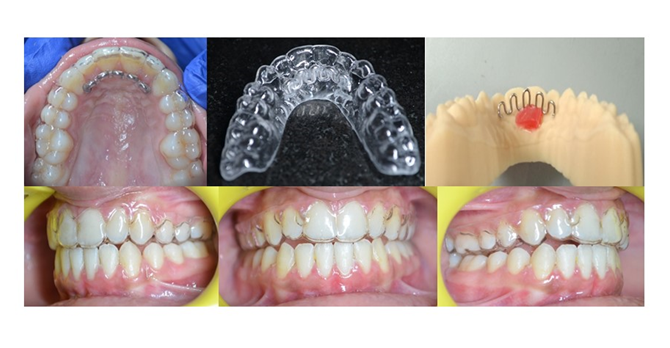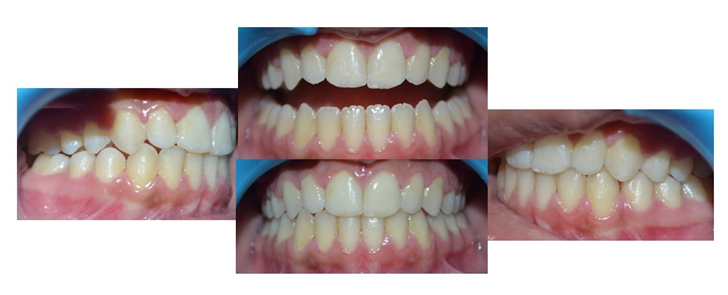Introduction
Anterior open bite is defined as condition in which there is a vertical gap between the maxillary and mandibular anterior teeth in centric relation. 1 Anterior open bite is the condition in which upper incisor crowns fail to overlap the incisal third of lower incisor crowns when mandible is brought into full occlusion. Within limits of this definition, degree or severity of malocclusion may vary from mild edge-to-edge relationship of incisor teeth to severe and handicapping malocclusion. 2
Dental anterior open bite is the characterised by decreased incisor dentoalveolar height, normal or less anterior and posterior vertical dimensions, incompetent lips, decrease incisal display at rest and smile.3, 4 There are several aetiologies for an open-bite like unfavourable growth patterns, heredity, oral habits, and tongue function and posture. 5
Diagnosis, treatment and successful retention of treated open-bite malocclusion continue to be constant subject of discussion and study, contributing to frustrations of clinicians. Studies related to aetiology, incidence, classification, characteristics, and treatment of this dysplasia have implicated many potential etiologic factors, including unfavourable growth patterns, digit-sucking habits, heredity, lymphatic tissue, tongue and orofacial muscle activity, orofacial functional matrices, mental retardation, and imbalances between jaw posture, occlusal and eruptive force, and head position. 6
Treatment of open bite is complicated by difficulty of differentiating among many possible dentoalveolar and skeletal etiologic factors, depending on patient’s growth pattern. The cephalometric measurements such as the mandibular plane angle, upper-to-lower facial-height ratio, and anterior-to-posterior facial height ratio have been used to identify vertical discrepancies, but these measurements do not always predict the treatment response and stability of an open-bite malocclusion.7
The open bite will sometimes correct spontaneously after the elimination of detrimental habits in early mixed dentition. Some of the treatment modalities include interceptive orthodontics treatment using removable Hawley appliance with screening device and habit breaker, tongue crib followed by phase II treatment, Haas appliance which is followed by Hawley retainer with tongue guard for stability(retention) after which phase II treatment follows, fixed orthodontic therapy with anterior elastics, and orthognathic surgery. 8 This case report showed patient had an anterior open bite with dental component. Treatment for this patient includes maintenance of the ideal overbite and overjet relationships, proper intercuspation with midline correction. After finishing treatment removable orthodontic retainer was provided with proper instructions.
Case Report
A 19-year-old female came to the clinic with the chief complaint of forwardly placed upper front teeth. The patient cited aesthetics as the main reason for desiring orthodontic treatment. The patient had no relevant dental or medical history. Siblings and parents of the patient did not have similar malocclusion, confirming that there was no hereditary component responsible for the patient’s malocclusion. There was no history of respiratory problems. On functional examination, it was found that the patient has a tongue-thrusting habit and thumb sucking habit. Intraoral examination revealed an anterior open bite of 6 mm with. No mandibular deviation or clicking noises were detected during opening or closing of her jaws. Panoramic and lateral cephalometric radiographs were taken before treatment. The panoramic radiograph showed no caries. (Figure 1) The etiology of the open-bite malocclusion appeared to be a combination of hereditary and habitual factors.
Treatment objectives
The following treatment objectives were established:
close the patient's open bite and create ideal overject and overbite,
correct the constricted maxilla
eliminate the tongue thrust,
correct the midline deviation,
obtain a stable occlusal relationship,
ultimately improve her dental esthetics by establishing anesthetic smile
Non extraction treatment plan was decided for patient. Patient was advised to perform tongue exercises to correct tongue-thrusting habit.
Preadjusted 0.022 slot mechanotherapy was used and initial wires were used for the alignment. After alignment, reverse NiTi was placed in upper and lower jaw. Box elastic was placed. (Figure 2) depicts occlusion status after appliance removal. Total treatment time was 18 months. Post treatment photographs have been taken (Figure 3).
As the patient responded well to the tongue exercise and once the bite was closed the tongue-thrusting habit stopped which meant that the patient had a secondary type of tongue thrusting.
Thus, a tongue crib was included during the treatment and retainer was given to the patient for nightwear. (Figure 3)
Patient was recalled after 1 year. (Figure 4)
Discussion
Cangialosi suggested that most patients with anterior open bite have the skeletal and dentoalveolar features contributing to malocclusion. Distinction between the skeletal and dental open-bite malocclusion is a practical matter because there should be different approaches for each condition to obtain an effective and stable treatment result.9
Various therapeutic modalities have been proposed for treatment of anterior open-bite malocclusion in both growing and nongrowing patients, depending on treatment objectives. Conventional orthodontic-orthopedic treatment has been directed at inhibiting the vertical maxillary growth with the headgear, retarding mandibular growth with chin cups, and extruding anterior teeth with the vertical elastics. Some other methods that have been used include tongue-crib therapy for habit control, posterior bite-blocks, posterior magnets, magnetic active vertical correctors, and functional appliances. 10
To achieve a stable result for the treatment of open bite, combination of fixed orthodontic treatment and myofunctional appliance is often implemented. During diagnosis, vertical dimension with the skeletal morphology need to measure properly for determining that open bite whether it is dental or skeletal. Proper diagnosis, treatment planning, and retention are critical to achieve most stable and favourable outcomes for patients with open bite malocclusion.11
This case report showed that the patient had an anterior open bite with the dental component. It is important to advise the patient for using retainer regularly to prevent relapse after active treatment. There is a possibility of relapse even if the patient practices strict retainer wearing. So, regular follow up in orthodontic clinic is essential to prevent relapse.





